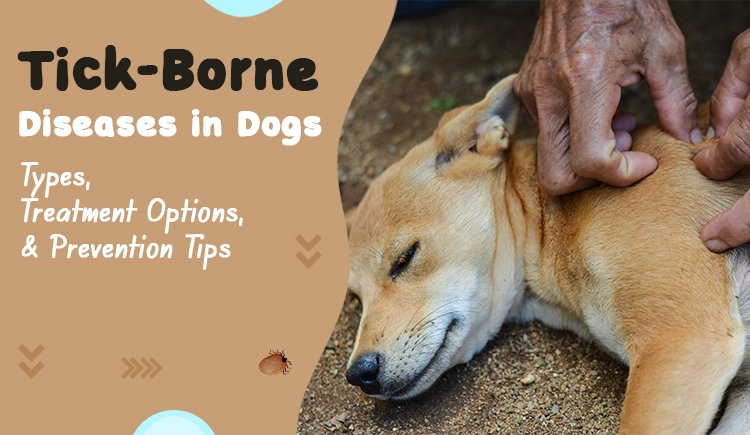Is Your Dog Really Safe? The Hidden Threats of Tick-Borne Diseases You Can’t Afford to Ignore
Ever wonder how something as tiny as a tick—barely the size of a sesame seed—can turn your joyful romp in the park into a vet visit nightmare? Those minuscule bloodsuckers aren’t just pesky; they’re stealthy villains carrying a cocktail of serious diseases that can sneak up on your furry buddy before you even notice. From the notorious Lyme disease to the lesser-known yet equally dangerous Hepatozoonosis, these tick-borne ailments don’t just bug your dog—they can truly disrupt their health and happiness in a heartbeat. If you’ve ever felt that gut-wrenching mix of worry and helplessness spotting a tick on your pup, you’re not alone—and I get it. That’s exactly why I’ve put together this deep dive into the common tick-borne diseases plaguing dogs today, how to spot the warning signs before things get scary, plus the latest on treatments and crafty prevention tips to keep your best friend tick-free and tail-wagging. Ready to become your dog’s health hero? Let’s jump right in! LEARN MORE

Ticks are small blood-sucking parasites, but the health issues they cause are in no way small. After a blood meal, they can leave parting gifts that you don’t want for your beloved furry companion. From Lyme disease to Hepatozoonosis, these tick-borne diseases in dogs can sneak up silently and escalate quickly, leading to unwanted consequences.
In this blog, we’ll explore the most common tick-borne diseases affecting dogs, primary warning signs, treatment options, and how to prevent them. With this information, you’ll be better prepared to navigate these dangers and get your pet the help they need.
We’re jumping right in!
Common Tick-borne Diseases in Dogs
In this segment, we’ll cover the common tick-borne diseases that your canine companion is susceptible to:
Lyme disease
Caused by the bacterium Borrelia burgdorferi, Lyme disease is one of the most well-known tick-borne illnesses in dogs. It is transmitted through a bite of an infected black-legged tick; however, the tick needs to be attached for about 24–48 hours to transmit the infection.
Symptoms: Dogs may show signs of lameness, swollen joints, fever, stiffness, fatigue, and loss of appetite.
Complications: In advanced cases, Lyme disease can lead to kidney damage (Lyme nephritis), heart issues, and chronic arthritis. Some dogs may develop neurological problems.
Anaplasmosis
Anaplasmosis is a bacterial disease caused by two types of bacteria: Anaplasma phagocytophilum, which affects white blood cells, and Anaplasma platys, which targets platelets. These bacteria are transmitted primarily by black-legged ticks (also known as deer ticks) and brown dog ticks.
Symptoms: Dogs may experience fever, joint pain, lethargy, vomiting, diarrhea, and even neurological signs like seizures in severe cases.
Complications: If left untreated, it can lead to serious complications in dogs, including organ failure, respiratory failure, and bleeding problems.
Ehrlichiosis
Ehrlichiosis is another tick-borne disease caused by infectious bacteria from the Ehrlichia genus. Caused by multiple species of Ehrlichia; however, two of the most common species found in the US are E. canis and E. ewingii. Transmitted through the bite of brown dog ticks and lone star ticks, this disease progresses through multiple stages, namely acute, subclinical, and chronic.
Symptoms: In the acute phase, dogs may show signs of fever, swollen lymph nodes, and bleeding disorders. Chronic infection can lead to weight loss, neurological issues, and bone marrow suppression.
Complications: If untreated, it can lead to severe anemia, kidney damage, and neurological issues.
Babesiosis
Babesiosis is a potentially dangerous parasitic infection caused by protozoa of the Babesia genus. Typically spread by the bite of American dog ticks and brown dog ticks, it can also be transmitted through the bite of an infected dog. Moreover, Babesiosis can also transmit through IV blood transfusions or transfer from mother to pup.
Symptoms: Dogs may suffer from pale gums, dark-colored urine, loss of appetite, fever, weakness, and jaundice.
Complications: Severe infections can result in anemia and organ failure.
Rocky Mountain Spotted Fever (RMSF)
RMSF is a serious bacterial infection caused by the infectious bacterium Rickettsia rickettsii. It can be transmitted by Rocky Mountain wood ticks, American dog ticks, and brown dog ticks, provided that the tick remains attached for 5–20 hours to transmit the bacteria.
Symptoms: Dogs may develop high fever, joint pain, abdominal discomfort, and swollen lymph nodes.
Complications: RMSF can damage blood vessels, leading to focal hemorrhages in the eyes or gums and nosebleeds if not treated promptly.
Hepatozoonosis
Unlike other tick-borne diseases, Hepatozoonosis is contracted when a dog ingests an infected tick rather than being bitten. It’s caused by Hepatozoon canis (via brown dog ticks) and Hepatozoon americanum (via Gulf Coast ticks).
Symptoms: Dogs may show signs of fever, lethargy, weight loss, muscle loss, and discharge from the eyes.
Complications: If not addressed in a timely manner, Hepatozoonosis can become a lifelong condition requiring ongoing management. Severe cases may lead to debilitation and death.
Symptoms to Watch For
Tick-borne diseases can manifest in a variety of ways. If your dog shows any of the following signs, it’s time to call your vet:
- Fever
- Lethargy
- Lameness
- Joint pain
- Muscle pain
- Reduced appetite
- Weight loss
- Breathing issues
- Pale gums
- Skin bruising
- Vomiting
- Diarrhea
- Bloody urine
- Enlarged lymph nodes
- Swollen belly or legs
- Eye or nasal discharge
- Yellowing of the eyes or skin
If you notice some or all of these symptoms in your dog, promptly contact your vet and take them for a check-up.
Treatment Options for Tick-borne Diseases in Dogs
When you take your pup to the vet, they will examine your dog to identify the type of tick-borne disease they have contracted. For further diagnosis, they may also take a few blood tests and craft a suitable treatment plan. The following observations can give you an idea of the tick-borne disease treatment approach.
- For bacterial infections, the vet may recommend broad-spectrum antibiotics to help eliminate the infection and reduce symptoms.
- In some cases, your dog may need to be hospitalized to provide emergency supportive care and stabilize the condition.
- The vet may administer tick prevention treatment such as Simparica Trio, Negard Spectra, Bravecto Chewables, etc., to manage the symptoms and prevent re-infestations.
- Along with treatments, the vet may recommend supplements and a balanced diet to support recovery.
Prevention Tips to Protect Your Pet
The following are some thoughtful measures you can take to keep your pet protected from the terror of ticks.
- Administer vet-approved tick preventatives, such as orals, topical or collars. Inspect your dog’s coat regularly, especially after walks in wooded or grassy areas.
- Keep your yard tidy by mowing the lawn and trimming bushes to reduce tick habitats.
- When going out for walks, avoid high-risk areas like dense woods and tall grass.
- Regularly clean your dog’s bedding and living space to minimize tick exposure.
- You can use suitable tick repellents, recommended by your vet, before outdoor activities.
- Schedule routine vet checkups to monitor your dog’s health and catch infections early.
- Remove ticks promptly and properly using fine-tipped tweezers. Grip close to the skin and pull straight out without twisting or crushing.
- Keep other pets protected too, as ticks can easily transfer between animals.
Parting Words
Tick-borne diseases can be a handful, but with the right knowledge, you can easily manage them. Always remember that prevention and early detection with swift action can make all the difference. So, put the information shared in this blog to good use and give your dog a playful and tick-free life. Good luck!




















Post Comment